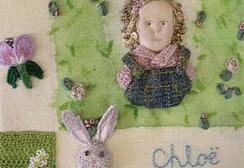


| About |
| Classes & Courses |
| Apprenticeship |
| Events |
| Retail |
| Online Shop |
| Studio |
| Tours |
| Friends of RSN |
| Fundraising |
| Arts and Craft Appeal |
| Useful Links |
| Vacancies |
| Home |
| Contact |
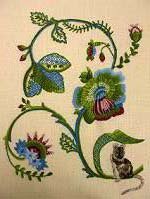 Classes for weekends and One, Two or Three days
Classes for weekends and One, Two or Three days
September 2005-September 2006
Choose from the following techniques and classes. The description given for each technique or class is a guideline only and we aim to develop each student and encourage him or her onto a higher level of achievement.
We have a reference library of design sources available to students. Our tutors will always help you with your design ideas and advise you how to transfer them on to the fabric.
Please click on the links below to read more about each course.
Beadwork
Blackwork
Canvas Design & Painting
Canvas Stitches
Cross Stitch
Beginners Goldwork
Goldwork Level 2
Goldwork Level 3
Goldwork with Silk
Creative Goldwork
Introduction to RSN Archives & Collection
Jacobean
Jacobean THREE DAY class
Knot Gardens
Tassels - for Tie-Backs & Cords
Whitework
Monogramming
Developing Whitework
The Introduction to Embroidery classes are ideal for students who do not know where to start. You will work a sampler of surface stitches and see a variety of embroideries from our Antique Textile Collection which will give you an insight into the various techniques available.
Beginners are welcome to attend the Introductory Classes in any technique. Some two and three day classes are also suitable and the class description will say if previous experience is necessary.
Beadwork
Choose to work Victorian-style beadwork or a sampler using beads, bugles and sequins. Try beading on a loom, or hand bead a three dimensional object using Peyote stitch.
Tassels can also be made during the two day classes and there is a one day class dedicated to experimenting with beaded tassels. Attend the Beadwork for Christmas class and learn how to make novelties for your tree and gifts.
Blackwork
A counted thread technique said to have been introduced to England by Catherine of Aragon and which frequently appears on Tudor costumes. The stitches form geometric patterns which can give stunning effects especially with architectural themes or portraits. Colours other than black can be used. We recommend some surface stitching experience to gain the most from the two day course, but you do not have to be very advanced in order to achieve good effects.
SPECIAL OFFER - 5% OFF THE FEES (INCLUDING 5% OFF FRIENDS' DISCOUNT WHERE APPLICABLE) IF YOU BOOK AND PAY TOGETHER FOR THE TWO DAY CLASS ON FEBRUARY 25TH & 26TH AND THE THREE DAY CLASS ON AUGUST 14TH, 15TH AND 16TH.
Canvas Design & Painting
During this stimulating day students will learn how to adapt, transfer and paint their chosen image onto canvas ready for stitching and will be introduced to canvas painting using either fabric or oil paints. A love of design and colour is the basic requirement. Students will be shown how to shade their designs to create depth and interest. All styles and designs can be tackled depending on experience.
SPECIAL OFFER - 5% OFF THE FEES (INCLUDING 5% OFF FRIENDS' DISCOUNT WHERE APPLICABLE) IF YOU BOOK AND PAY TOGETHER FOR THIS DAY ON APRIL 18TH AND CANVAS STITCHES ON APRIL 22ND AND 23RD.
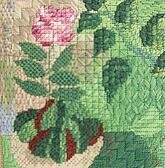 Canvas Stitches
Canvas Stitches
Learn how to work a variety of canvas stitches and explore the use of different textured threads for traditional pieces or contemporary designs. Graduate the colours on your design to give depth and movement to your work. No previous experience necessary. Bring your own kit if you wish, or we can supply ideas to work samples.
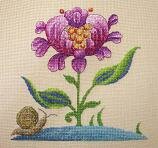 Cross Stitch
Cross Stitch
Work a small band sampler incorporating a variety of stitches. More complex cross stitches could include some beading and Assisi work. Assisi is an Italian technique with examples dating from the 13th Century and incorporates motifs enclosed with backstitch, a cross stitch background and decorative borders.
Goldwork levels mentioned below are only a guide and the classes at levels 2 and 3 will be tailored to your ability by our friendly and experienced tutors. Please do not be afraid of progressing to another level.
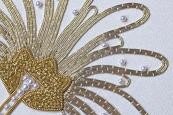 Beginners Goldwork
Beginners Goldwork
For those that have not done any goldwork before.
For either one or two days with a choice of weekdays or weekends. A one day class will cover simple padding with felt, basic couching (laying the thread down and sewing over it), using pearl purls, Japanese thread and chips (cut gold threads) to create various effects. In view of the limited time available on a one day class, a kit containing a design and all the materials required will be for sale on the day.
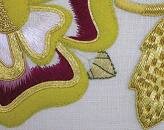 Goldwork Level 2
Goldwork Level 2
For those who have attended a Beginners' class or who have had previous experience of goldwork.
This offers a choice of one, two or three day classes including Saturday classes. Progress to padding with felt and soft string, couching with pearl purls and gold chips, use a greater variety of gold threads such as rococo and twist with practise cut work (cutting thread to the correct length and couching it down). Designs will be available, but students attending for two or three days may wish to create their own design using our library and archives for inspiration.
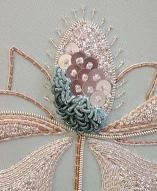 Goldwork Level 3
Goldwork Level 3
For students who have attended goldwork classes at the RSN, or have a good deal of experience in this technique.
An opportunity to progress to padding with carpet felt, adding "S"ing and the use of gold plate, spangles and leather kid. Some designs will be available, but students will be encouraged to create their own designs and are welcome to bring their own existing projects.
Goldwork with Silk
A three day course working with traditional techniques of gold and metal work combined with richly coloured applied silk fabrics. This course is suitable for Level 2 & 3 students and is particularly useful for church work.
Creative Goldwork
Traditional goldwork with a different approach. Explore the diversity of creative techniques that can be worked using metal threads. The two day class in March is suitable for students who have no previous experience of goldwork. Students attending the three day class in July should have attended RSN goldwork classes up to level 2.
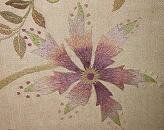 Introduction to RSN Archives and Collection
Introduction to RSN Archives and Collection
A day devoted to explaining our work in relation to our Collection of Antique Textiles and written archives. The RSN's archivist, Dr Lynn Hulse, will talk about her work collating the Collection and writing about the history of the Royal School of Needlework. Eva Hansson will describe the diversity of our textile Collection, and Helen McCook a former Apprentice who now works in the Textile, Fashion & Costume Department at Bonhams, will explain how her training as an embroiderer relates to her present work and also displays and discusses the RSN's Collection of needlework tools.
Jacobean
This decorative technique, popular in the 17th Century and hence the designation 'Jacobean', is one of the earliest forms of surface embroidery. It is traditionally worked in crewel wool on linen. No previous experience of working Jacobean/Crewel work is required and you may choose to work the traditional Jacobean style or more modern crewel work. A number of different stitches are taught and you can choose from a selection of designs.
Jacobean THREE DAY class
If you have already attended a Jacobean course, why not use this three day course to plan and begin a project such as a stool cover, cushion, picture or even a bedspread or curtains ( fabric size for very large projects must be discussed before the class as we do not carry wide sizes in regular stock). You can design and plan your stitches using our Collection pieces and archive sources for inspiration. Design ideas will also be available for students who do not wish to do their own projects.
Knot Gardens
Using 17th Century designs and the grounds of Hampton Court Palace as inspiration, we will show you how to create your own three dimensional design on canvas. Use textured stitches in a variety of threads to create flower beds, topiary hedges and water features. The class in September/October is for students who wish to begin a Knot Garden. The classes in June and August are for those who have already started and have work to progress. Some experience of canvas stitching is desirable.
Miniature Embroidery
Learn the technique of creating miniature embroideries suitable for use as jewellery or as doll's house accessories and fittings. Basic embroidery experience is necessary for this class.
Mounting
Learn to mount your work onto acid free card so that it is ready to put in a picture frame.
Ribbon Embroidery
Stitch using silk ribbon combined with surface stitches in stranded cotton to 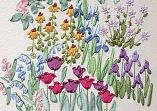
Silk Shading
T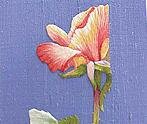 his beautiful technique uses cotton or silk threads and is sometimes known as 'painting with a needle'. Once you have mastered the basics, you really will improve as you practise. The Introduction Day will give a 'taster' for this technique and is designed with the inexperienced stitcher in mind. You will be given a simple design and will learn how to work directional long and short stitch. The two or three day class allows you to work a more complex design of a flower, fruit or vegetable and you will learn additional technical details and how to accomplish a 'turnover'.
his beautiful technique uses cotton or silk threads and is sometimes known as 'painting with a needle'. Once you have mastered the basics, you really will improve as you practise. The Introduction Day will give a 'taster' for this technique and is designed with the inexperienced stitcher in mind. You will be given a simple design and will learn how to work directional long and short stitch. The two or three day class allows you to work a more complex design of a flower, fruit or vegetable and you will learn additional technical details and how to accomplish a 'turnover'.
SPECIAL OFFER - 5% OFF THE FEES (INCLUDING 5% OFF FRIENDS' DISCOUNT WHERE APPLICABLE) IF YOU BOOK AND PAY TOGETHER FOR THE ONE DAY CLASS ON JULY 14TH AND THE THREE DAY CLASS ON AUGUST 9TH, 10TH AND 11TH.
A delightful and addictive technique of miniature raised embroidery originating in the 17th Century. The introduction day requires some experience of surface stitching. Try your hand at some of the wide variety of stitches/techniques involved such as needlelace and the making of "slips". Create charming images of bugs, flowers and miniature portraits. Some experience of surface stitching would be helpful.
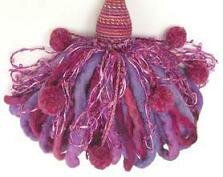 Tassels for Tiebacks & Cords
Tassels for Tiebacks & Cords
Make cords and large tassels using wooden moulds.
Whitework
Whitework is embroidery worked in white thread on a white background and covers a variety of delicate techniques. We would recommend some experience of surface stitching in order to gain the most from the class.
Personalise individual gifts for family and friends by learning these basic techniques. You will work samples of trailing, satin stitch, eyelets, bullion and French knots to create designs and lettering for linen and clothing. Please note that gift/dress making is not included in this class.
Developing Whitework
You should have attended a general whitework class or have some experience of working whitework techniques.
-
Ayrshire Whitework was developed in 19th Century Scotland. Traditionally used for christening gowns and handkerchiefs for example, it uses satin stitch, eyelets and needlelace fillings worked on fine cotton lawn.
-
Fine Whitework is a complex technique using a layer of net sandwiched between two layers of fine linen. Layers are cut away and various delicate stitches are used to develop the design.
These techniques demand patience and precision but achieve stunning effects.
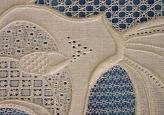 Contemporary Whitework
Contemporary Whitework
A new approach to Whitework using traditional techniques in contemporary ways with different fabrics and threads. The emphasis is on the use of texture and working non-traditional designs. This class is suitable for students who have not worked whitework previously.
